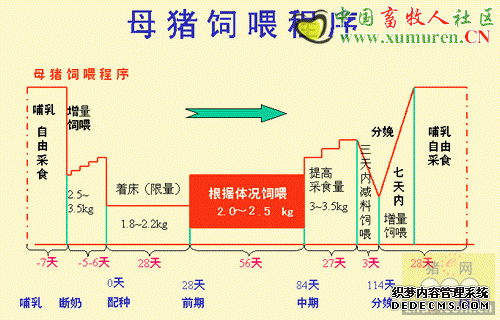Feed Intake - A Checklist of Nutritional, Environmental and Management Strategies to Achieve Success
Furthermore, pigs subjected to space restrictions didnot exhibit any compensatory gain upon being provided with additional space, increasing only tothe level that was typical for their weight range.The negative effects of exposing pigs to reduced space on ADG are not corrected by feedingpigs diets with high nutrient density. These observations suggest that reduced space leads tochronic stress that eventually impairs the efficiency of feed utilization. Moreover, spacerestriction in pigs may alter biochemical mechanisms and cause behavioral changes (e.g.increased aggression), which in turn diverts dietary energy away from being used for growth.
Regrouping
Regrouping strange pigs is commonly practiced as pigs move through a production facility.Mixing strange pigs leads to reductions in FI and ADG and this impact seems to persist evenafter pigs are re-united with their previous pen-mates. Based on these observations at PrairieSwine Centre, we can conclude that market pigs should not be regrouped with strangers, 2weeks before shipping. Regrouping 8-week-old pigs has shown not to have any long-term effecton production levels thus indicating that regrouping is a transient stressor that pigs canovercome if given sufficient time.
Group size
The number of pigs to be kept in a single pen is an important consideration in a swine farm notonly because of its influence on barn design but also because of its possible influence on FI andoverall performance of pigs. The effect of group size on FI in pigs has not been observedconsistently. Whereas some studies have reported a decline in FI as the number of pigs pergroup increases, others have not. Recent research at the Centre shows that overall feed intakeand ADG were not effected by group size. However significant differences in ADG wereobserved during the first six weeks of the study. Dr. Gonyou notes that in these trials withgroups of 10, 20, 40 and 80 pigs per pen, feeder location, and space were optimal and thatdifferent results could be expected under other circumstances. In this case feeders werepositioned across one end of the pen and one single-space feeder accommodated 10 pigs.Social interactions among group-housed pigs together with the extra effort required to accessfeed when pigs are housed in a larger space may be responsible for the observed reductions inFI. This is an important area of research emphasis at the new Elstow Research Farm wherelarge groups can be accommodated in all ages of pigs.
HEALTH
The health status of an animal is an important determinant of overall performance. In general,the immune system responds to the presence of pathogenic agents by synthesizing andreleasing compounds known as cytokines, which in turn activates cellular and humoralcomponents of the immune system. High activation of the immune system represents a form ofstress (i.e. immunological stress) and pigs use physiological and behavioral strategies tomaintain homeostasis during a disease challenge. During disease infection, potential anabolichormones are inhibited and voluntary FI, ADG and FE are reduced from 5-24%. Recentresearch shows that pigs with activated immune systems have lower voluntary FI, FE, and bodyprotein accretion compared to those with low immune system activation.
In addition to compromised FI and growth performance, disease infection also influences howanimals use dietary nutrients for various body functions. Diseased animals exhibit a shift in thepartitioning of dietary nutrients away from lean muscle accretion towards metabolic responsesthat support the immune system and also accelerates the breakdown of muscle proteins.
GENETICS
The genetic potential for gain varies with different genetic lines. Feed intake levels and FIpatterns differ between pigs of divergent genetic lines. A variety of experiments havedemonstrated that certain breeds of pigs, notably the Duroc, have a higher capacity for ad libitumfeed intake than other breeds. While such data is interesting, one must recognize that variationswithin a breed are often greater than among breeds. Pigs selected for faster gain exhibit higherFI levels compared to those with slow gain potential. In general, daily FI level is directly relatedto the respective daily amounts of lean and fat deposited (about 3 to 4 times more energy isrequired to deposit fat compared to lean tissue) and the efficiencies for utilization of dietaryenergy for the accretion of body components. Pigs with a high potential for lean tissue growthtend to have a lower voluntary FI compared to those with low muscle accretion rate.
FEED
Feed Composition
Feed composition in terms of nutrient content and nutrient balance is an important determinantof FI in swine. In general, pigs consume feed to meet their nutrient requirement and therefore,the energy content of a diet has a great influence on FI. The pig has evolved to utilize a widerange of feed ingredients and although pigs can adjust their FI to compensate for low dietarynutrient density, the actual voluntary FI may be limited by the physical nature of the diet, isperhaps related to gut fill or passage rate before adequate nutrients are consumed.
声明
来源:互联网
本文地址:http://farm.00-net.com/yz/zhu/5/2007-09-20/142401.html








